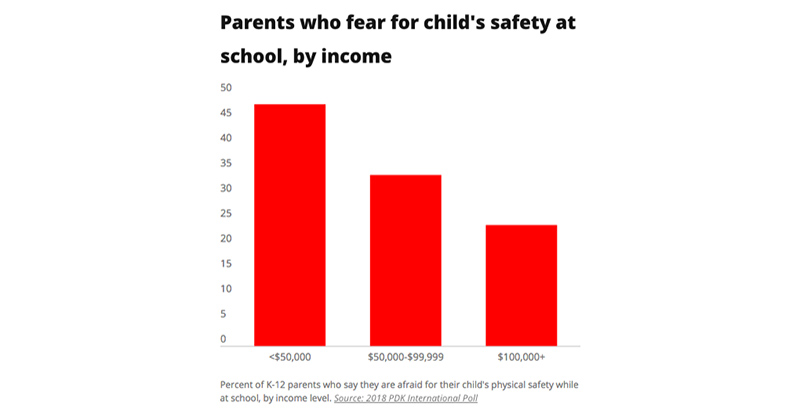American Schools Are Safer Than Ever, but Annual Education Poll Reveals 1 in 3 Parents Now Fear That Their Children Are in Danger on Daily Basis

The number of Americans who fear for their child’s safety in school has nearly tripled over the past five years, according to a new survey.
Still, the majority of Americans believe their kids are safe at school. The poll found that 34 percent of parents said they feared for their child’s physical safety, while 65 percent said they did not. In 2013, only 12 percent said they were afraid.
The findings were published by PDK International Poll, which conducts an annual survey of attitudes toward education.
“One in three parents fears for their child’s safety, and I think that’s an important finding to keep in mind — that’s a heck of a lot,” Gary Langer, president of Langer Research Associates, which conducted the poll, said during a call with reporters. “Not only that, but there are groups, demographic groups, in which it goes considerably higher. Look at the income breaks.”
Almost half of parents surveyed who make less than $50,000 said they feared for their child’s safety at school, compared with only one-quarter of parents who earned more than $100,000. Political differences appeared in the poll as well: Democrats were 20 points more likely than Republicans to fear for their children’s safety.
However, federal education data show that schools are historically safer than ever, with fewer reports of violent crimes and homicides. Between 1992 and 2016, crimes at school ranging from theft to serious violent victimization declined across demographic groups.
Pollsters correlate this public fear with recent deadly school shootings. A shooting in Parkland, Florida, killed 17 people this year, followed a few months later by a shooting in Santa Fe, Texas, that killed 10. The last time the PDK International poll found numbers this high was after two deadly school shootings in Arkansas and Oregon in 1998 that received extensive media coverage, pollsters said.
But researchers have also found that school shootings are not on the rise and are rare. A Politico report pointed out that since the 1980s, it’s the number of victims, not the number of shootings, that has increased. But that could be generating more media coverage and causing a false perception of the frequency of school shootings.
When it came to how to make schools safer, more than three-quarters of respondents said they supported armed guards, mental health screenings, and metal detectors. When asked to choose what schools should spend money on, about three-quarters said they’d rather have mental health services prioritized over armed guards.
This favorable view of mental health services across demographics and political leanings is supported by past polling data from PDK, which found broad support for more funding for wraparound services at school, said Joshua Starr, CEO of PDK International.
But arming teachers was a much more divisive issue among poll respondents: 57 percent of Republicans supported educators carrying guns, compared with 17 percent of Democrats. Additionally, 80 percent of black and Hispanic parents do not want their children in classrooms where a teacher has a gun.
Superintendent Brian Osborne of the New Rochelle City School District in New York said polls like these are important this time of year, as superintendents and school boards are making decisions on how to keep their schools safe.
“There is a real imperative to increase safety and the public’s perception that children are safe at school,” Osborne said on a media call with reporters. “That’s the most important issue that is facing school districts right now.”
But he said districts must be careful to not create environments that cause overpolicing and sow distrust among students toward adults. Districts like New Rochelle also run up against funding issues and find increasing taxes a difficult sell among voters, even if it’s for services like additional school psychologists.
Other polls conducted this year have also found an increase in fear among families over school shootings. A Pew Research Center poll found that the majority of parents and students are afraid of shootings happening at their school, and those from lower-income and minority families are more afraid than their wealthier, whiter peers.
Students are even missing school because they are more afraid. Over the past 25 years, more students said they are skipping school because they fear for their safety, even though these same students report fewer incidences of violence, bullying, or weapons in school, according to data from the National Youth Risk Behavior Survey.
The PDK International poll was conducted online among a nationally representative sample of 1,042 adults. The margin of error is plus or minus 3.89 percentage points. These questions around school safety were an early release of PDK International’s annual education poll, which will be published in August.
Get stories like these delivered straight to your inbox. Sign up for The 74 Newsletter

;)
